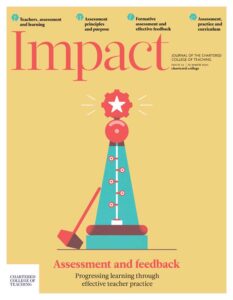Formative assessment for online learning: Implementing classroom strategies in the online forum

Emily Walker, Gallions Primary School, UK
Feedback is a vital part of classroom practice but how does formative assessment translate to the online classroom?
When providing students with feedback online, there are a number of challenges to consider: the lack of immediate, face-to-face interaction or clarification; the potential lack of structure to the format of the student’s day; and technological abilities (both student and teacher) adding another element to the learning that may not be directly related to the particular learning journey (Yen et al., 2018).
Comment-only feedback
With online learning, making sure that students check on their feedback can be tricky, meaning that instant, grade-based activities can seem like a better option. However, a grade alone cannot provide enough detail for the students to be able to move forward with their learning, as it doesn’t give them ways in which to overcome any difficulties that they have faced (Black et al., 2003; Hattie, 2009, cited in Hattie and Clarke, 2019). Some of our students admitted to using search engines or ‘asking Alexa’ when completing closed tasks, as well as redoing multiple-choice tasks in order to improve their scores, without actually understanding how or why they were incorrect in the first place. It appeared that they had been extremely successful in their learning when, in actual fact, they had not developed their subject knowledge sufficiently and misconceptions remained.
Providing students with feedback to support learning is much more effective when it is provided in the form of a comment, ensuring that students meet the requirements of a task, through reflection or even resubmission. If a student has been successful in their tasks, then improvement feedback is not required and this information should be used to develop future learning.
According to the Education Endowment Foundation’s review into remote teaching (2020), whether feedback is live or recorded is irrelevant as long as the quality of the instruction or feedback promotes the development of students’ understanding. Thus, the feedback given was either video-recorded, streamed via live Google Meets, sent as voice notes or written, depending on the nature of the feedback and the student receiving it.
Grades are generally best left to activities where there will be no requirement for the students to act upon the grade, such as knowledge checks at the beginning or end of a unit.
Verbal feedback
The University College London (UCL) Verbal Feedback Project (Quin and McGill, 2019) outlined that verbal feedback can have the same impact on student progress, attainment and engagement as written comments. Interaction needs to be targeted and of high quality in order for it to hold value (Gershon, 2017).
In order to give timely, relevant feedback in an efficient manner, voice notes or links to short videos explaining areas of need were sent to targeted individuals or groups. Arranging group feedback as a recording also meant that the teacher delivered targeted, timely intervention to numerous pupils in one go. It was noted by pupils that video messages were easier to understand and act upon than typed feedback, as they could be signposted to the focus area more easily.
E-portfolios
One way of monitoring student progress online is the use of e-portfolios. The creation of a learning sequence that builds up students’ skills or knowledge base towards an outcome helps to provide teachers with step-by-step feedback on the skills and knowledge that students are and aren’t competent with (Hattie and Clarke, 2019; Fletcher-Wood, 2018). The use of e-portfolios helped students to easily access previous learning, providing opportunities to go back over their learning or access previous lessons, in a similar way to flicking back through a workbook. This created a body of evidence of outcomes, and therefore teachers were able to assess the effectiveness of the learning journey as it unfolded and amend accordingly.
By having a central portfolio of learning, students can also be encouraged to share in an open and interactive environment and learn from peers. (McLaughlin and Yan, 2017; Yen et al., 2018).
Peer feedback online
It is important for students to be given clear examples of what is expected from them (Nottingham and Nottingham, 2017; Hattie and Clarke, 2019). This is easy to present online; however, the value is often in the discussion and teacher guidance (Spendlove, 2011; Nottingham and Nottingham, 2015).
Collaborative learning through discussion boards and shared platforms is one way to overcome the lack of in-person interaction, allowing for students to share comments with one another (McLaughlin and Yan, 2017). Peer feedback can be extremely useful as a formative assessment tool, as it allows students to experience other outcomes and reflect upon the learning intentions (McGill, 2017).
Using videos that modelled feedback, as well as inviting other adults into live sessions to model feedback discussions, exposed the students to expectations around discussion. At first, the experience of peer feedback was convoluted. Allowing students choice of whom to share feedback with left some students with too much and some too little feedback. Subsequently, students were matched to ensure an appropriate and balanced feedback experience. We found that students were better ‘critical friends’ when partnered with someone whom they trusted and respected.
While social aspects of peer feedback are appropriate for primary students, such as shorter prompt questions on discussion boards, peer feedback can be difficult in an online learning scenario, as the absence of the facilitator will limit the quality of the feedback and primary pupils may require more support to ensure high-quality discussion (Ng, 2016, cited in Yen et al., 2018; Kim and Ryu, 2013, cited in Yen et al., 2018).
Prompt questions were posed but heavily modelled with adult comments, again exposing the students to the expectations. The quality of the peer feedback did vary, with some students finding it harder to make any meaningful comments initially, but offering modelled feedback sessions, where one student would present their work and adults would offer feedback, helped to demonstrate good feedback practice. A potential problem with this is that the more confident and technically capable children can dominate the conversation while others slip away behind a turned-off camera. In response to this, teachers regularly shared various outcomes from a range of students at the teachers’ discretion. Students were also encouraged to voluntarily share work on the class discussion board. This helped to improve the quality of peer reviewing and students were often excited about seeing the feedback on their work live and they tended to care more about the work they produced when sharing in this way.
It is also worth noting that varying technology access for students will create inequalities. Some will be able to share quality outcomes or access video or live-streamed content, whereas others may have difficulty doing so. In addition to this, the support from adults in the home environment, the resources available (including attention/knowledge from members of the household, as well as physical resources), the influence of members of the household and the home environment itself will vary greatly from home to home (Yen et al., 2018; Cullinane, 2020). Providing recorded videos of teaching sessions for those who are device-sharing helped to alleviated some of these issues, and ensuring that tasks can be completed in a variety of ways (such as on paper, which can be photographed and then uploaded) is essential to addressing inequalities. Being mindful of what all students will be able to access and produce when at the planning stage of distance teaching is also imperative.
By finding ways to motivate learners and ensure that feedback is working for them, teachers can create a constructive view of feedback as a useful tool for learning (Allison and Tharby, 2015; Gershon, 2017). It is important that feedback is a channel of communication between student and teacher. Teachers need to ensure that students are aware of their learning progress, in order for students to take responsibility and be accountable for their learning outcomes, as well as promote positive learning behaviour to ensure that a good level of learning progress is made (Nottingham and Nottingham, 2017).
References
Allison S and Tharby A (2015) Making Every Lesson Count: Six Principles to Great Teaching and Learning. Carmarthen: Crown House Publishing.
Black P, Harrison C, Lee C et al. (2003) Assessment For LearningKnown as AfL for short, and also known as formative assessment, this is the process of gathering evidence through assessment to inform and support next steps for a students’ teaching and learning: Putting it Into Practice. Berkshire: Open University Press.
Black P and Wiliam D (1998) Inside the Black Box: Raising Standards Through Classroom Assessment, 1st ed. Brentford: GL Assessment.
Cullinane C (2020) COVID-19 and home-schooling: The crisis has exacerbated and highlighted existing educational inequalities. LSE. Available at: https://blogs.lse.ac.uk/politicsandpolicy/home-schooling-covid-19 (accessed 14 May 2020).
Education Endowment Foundation (2020) Remote Learning, Rapid Evidence Assessment. London: Education Endowment Foundation.
Fletcher-Wood H (2018) Responsive Teaching: Cognitive ScienceThe study of the human mind, such as the processes of thought, memory, attention and perception and Formative Assessment in Practice, Kindle ed. Oxon: Routledge.
Gershon M (2017) 50 Quick Ways to Improve Feedback and Marking, Kindle ed. California: CreateSpace Independent Publishing Platform.
Hattie J and Clarke S (2019) Visible Learning: Feedback, 1st ed. Abingdon: Routledge.
McGill RM (2017) Mark. Plan. Teach, 1st ed. London: Bloomsbury.
McLaughlin T and Yan Z (2017) Diverse delivery methods and strong psychological benefits: A review of online formative assessment. Journal of Computer Assisted Learning 33: 562–574.
Nottingham J and Nottingham J (2017) Challenging Learning Through Feedback: How to Get the Type, Tone and Quality of Feedback Right Every Time. Thousand Oaks: Sage Publications.
Quin M and McGill R (2019) UCL Verbal Feedback Project Report 2019. Available at: www.ucl.ac.uk/widening-participation/sites/widening-participation/files/2019_verbal_feedback_project_final_4_print.pdf (accessed 9 March 2021).
Spendlove D (2011) Putting Assessment for Learning into Practice, 3rd ed. London: Continuum.
Yen M-H, Chen S, Wang C-Y et al. (2018) A framework for self-regulated digital learning (SRDL). Journal of Computer Assisted Learning 34: 580–589.










